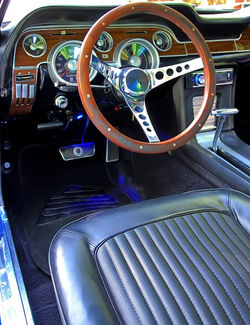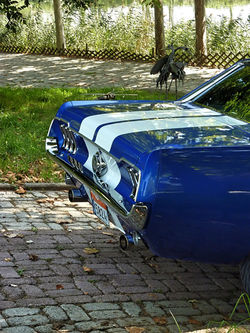
1968 Ford Mustang 289




All photography work is copyrighted by the author, please don't download and publish these pictures in the internet without my permission!
Larger high quality pictures is available only for donators up on request! Vasileios Papaidis 2017 © All Rights Reserved
The Mustang was introduced at the 1965 New York World's Fair, Mustang Mania instantly swept the country, and a new automotive market §egmènt was created - the 2+2 or better known as the 'ponycar.' Though its mechanical underpinnings descended from the Falcon, the Mustang was completely different. It was a compact, tight, clean package weighing in at a modest 2,550 pounds - a departure from the ever-enlarging American cars of the day. The classic long-hood short-rear-deck combined wîth a forward-leaning grille, elegant blade bumpers, sculptured body sides, fully exposed wheel openings and restrained use of bright trim gave the car a unique look that belied its affordability. Its looks were backed up wîth power, providing three optional V8 engines wîth up to 271 horsepower. Other options included automatic transmission, power §teering and brakes, styled chrome wheels and air conditioning. Not surprisingly, the entry-level modes were a minority of the production.
To say that the first Mustang was a success is an understatement. Following the introduction, the Mustang was on the cover of both Time and Newsweek. A week before introduction, Ford ran ads wîth the air times for the first television commercials, which all three networks broadcasted simultaneously. Mustang was selected as the Official Pace Car for the 1964 Indianapolis 500, and more than 22,000 orders were taken the first day. By its first anniversary, over 418,000 Mustangs had been sold, breaking the all-time record for first year sales of a new nameplate.
The original platform was used, wîth numerous modifications, up to 1973. The Pinto-based Mustang II was built from 1974 until 1978. A new fox body platform began in 1979 and was largely unchanged through 1993. In 1994 the SN-95, a modified version of the Fox body, debuted and was produced until 2004. The 2005 Mustang is built on the first entirely new platform in 25 years.






The driving experience of an American muscle car like this one is wonderful,the high performance 289 engine push the car really fast and the steering wheel is very accurate and easy to have the full control of the powerful mighty Mustang.The Ford Mustang as the first -- and so far the only -- car to receive the Tiffany Award for Excellence in American Design.
Special thanks to mr. Dimitrios Kirkos for the concession of the car and mr.George Dimopoulos for the precious assistance in photography work at this project...we love classics and enjoy the new challenges!
Vasileios Papaidis
Crankshaft design for this engine became the subject of a special study. The crank is made of precision-cast alloy iron and runs in five main bearings. About 70% of the total unbalanced couple is balanced by counterweights on the crankpin webs, and the remaining 30% is balanced by two external counterweights—one mounted in front of the timing sprocket and the other integrally with the flywheel. In most previous passenger car applications of this engine, the fourth harmonic unbalance occurs beyond the normal speed range. But on the high-performance 289 the fourth harmonic comes within its 7000-rpm range, so the vibration damper developed for the Indianapolis engine, with enlarged rubber contact areas and tuned for higher crankshaft speeds, was adapted.
The high-performance 289 also has the cross-bolted crankcase from the Indy engine, plus -a number of special design features such as high-tensile strength connecting rods, copper-lead alloy bearing shells, chrome-plated valve stems, mechanical valve lifters, and a high-lift, high-overlap camshaft. The cylinder heads give a compression ratio of 10.5-to-one, and the air intake system consists of a low-restriction air cleaner, an opera-throat four-barrel carburetor, and direct manifold passages. The exhaust system boasts individual headers merging into twin tail pipes. Power output is an impressive 271 bhp at 6000 rpm with a maximum torque of 312 lbs-ft at 3400 rpm. Naturally this unit can be tuned still further for racing purposes by such patent medicines as Dr. Shelby's Cobra Elixir (or imitations available from your local Performance Drugstore). Over 300 bhp may be reached without impairing engine reliability. Specific output of the hottest production model Mustang engine is 0.95 bhp per cu in, as against 0.73 for the standard 289-cubic-inch power unit.
In the Mustang, the 289 in stock form gives bushy-tailed performance and encourages enterprising driving methods, greatly aided by the precise gate and well-chosen ratios and excellent synchromesh of the four‑speed transmission. American manufacturers, be it GM, Ford or Chrysler, are really spoiling us with their faultless synchro systems, and the bad examples from abroad are becoming harder and harder to endure.
For some obscure reason, the 260-cu in V-8 can only be supplied with the 3-speed all-synchro transmission (or the 3-speed automatic). The 289 comes with either the 4-speed manual or the 3-speed automatic and the all-synchro four-speed gearbox is mandatory with the high-performance V-8.
Mustang grille design seems a poor disguise for an air intake, and frontal appearance is marred by gaps between body panels.
Floor-control is used for all transmissions; a rugged lever with a large spherical knob for the manual options and a T-handle for the automatic. This new automatic, designated the C-4, was introduced on the 1964 Fairlane and Mercury Comet series.
The selector quadrant has six positions: P-R-N-D1-D2-L. Starting off in D, gives first gear, while D2 does not engage low gear so as to reduce the risk of wheelspin on slippery surfaces. L position works as a hold switch for low gear. The lever can be moved to L at any speed, but over about 15 mph it engages intermediate instead of low, and braking effect is mainly dependent upon the good old friction materials.
The C-4 consists of an 11-1/4 -in diameter torque converter with a maximum torque multiplication of 2.40-to-one (at stall) and an input torque capacity of 275 lbs-ft. The converter works in combination with two sets of planetary gears engaged by one-way disc clutches and locked by brake bands, with a 2.46-to-one first and a 1.46-to-one intermediate. Full-throttle shift points are about 40 and 70 mph, but acceleration is improved by holding Low up to 50 mph. There's no intermediate hold device. Reverse ratio is 2.20 to one. The C-4 automatic weighs only 145 lbs complete, mainly because the main castings are made of aluminum.
Both three-speed manual transmissions have greater mechanical efficiency than the automatic, and the all-synchro version (as used with the 260 V-8) is pleasant enough to use. But why Ford won't supply a synchromesh first with the less powerful six-cylinder engine, which needs bottom gear more frequently, is a mystery to us. True, the torque of the 170 six is so substantial as to make second-gear starts relatively easy, but that doesn't explain why 6-cylinder Mustang drivers have to learn double-clutching before they can engage first gear while in motion. Possibly Ford's market research indicates that everybody who is interested in acceleration buys a V-8 and four-on-the-floor. And those second-gear starts, by the way, have been made possible by using a lower shorter intermediate gear than the all-synchro three-speed box:
Non synchro All
1st synchro
1st 3.29 2.79
2nd 1.83 1.70
3rd 1.00 1.00
For the six-cylinder engines, the driveshaft is a shortened version of the Falcon's; for the V-8 models it's a shortened Fairlane shaft. Final drives are lifted freely from other lines—with six-cylinder engines the ring gear and pinion are standard Falcon, with 260 and 289 V-8s they are standard Fairlane, and with the high-performance "289" they are of Galaxie origin.
The differential housing for the Falcon gears is made of malleable iron with an integral carrier—the other models use a pressed steel housing with removable differential carrier. Ford's Equa-Lock limited-slip differential will be optional with all power-team combinations.
Photo Gallery
 |  |  |
|---|---|---|
 |  |  |
 |  |  |
 |  |  |
 |  |  |
 |  |  |
 |  |  |
 |  |  |
 |  |  |
 |  |  |
Photo Gallery 2
 |  |  |
|---|---|---|
 |  |  |
 |  |  |
 |  |  |
 |  |  |
 |  |  |
 |  |  |
 |  |  |
 |  |  |
 |  |  |